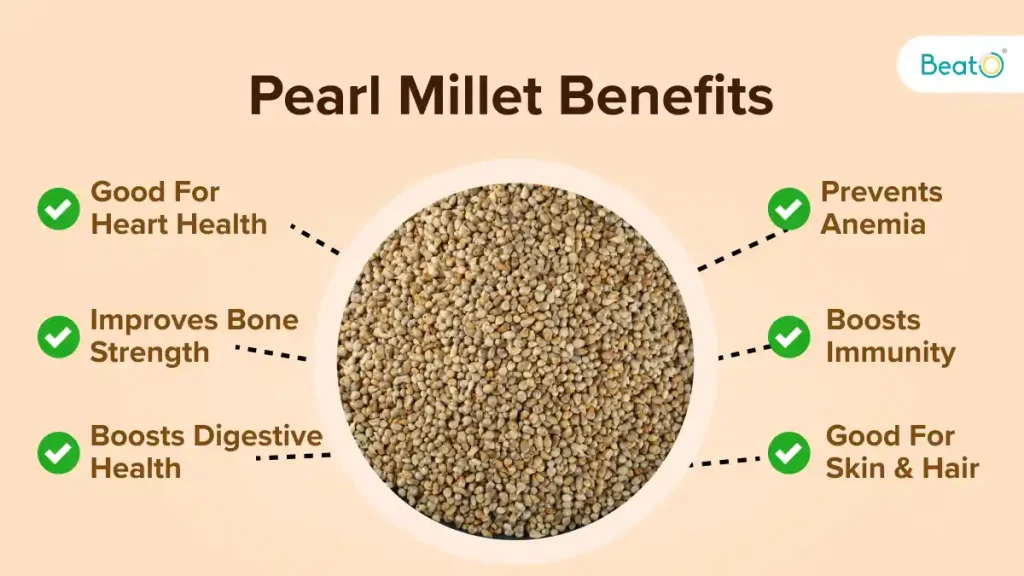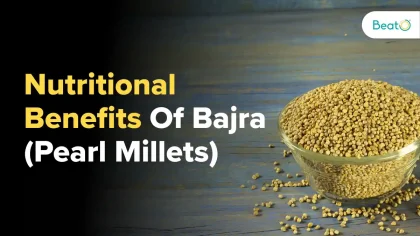Bajra or Pearl Millet, is a popularly grown cereal crop in India and it has been an integral part of the Indian diet for many years. Scientifically known as Pennisetum Glaucum, Bajra can survive in marginal areas where the soil conditions are dry. Aside from helping farmers to be sustainable, its nutritional richness such as proteins, fibres, vitamins and minerals makes Pearl Millet an important food source in the Indian community.

Pearl Millet benefits by focusing on weight management, promoting cardiovascular health and enhancing resistance to diseases by boosting immunity. Because of these benefits, Bajra is not just a dietary staple but is also good for health. Here we explore the pearl millet benefits of including it in our meals and the advantages embedded in the culinary use of this grain.
Also Read:7 Incredible Bottle Gourd Benefits For Healthier You
Nutritional Profile of Pearl Millet (Bajra):
| Nutrient | Value (per 100g) |
| Calories | 378 kcal |
| Protein | 11g |
| fibre | 12g |
| Fat | 4.2g (Majority being unsaturated fats) |
| Carbohydrates | 73g (Primarily complex carbohydrates) |
| Vitamins | Rich in B vitamins (Especially Niacin, Riboflavin, Thiamine, and Folate) |
| Minerals | High in Mineral (Magnesium, Phosphorus, Potassium, Calcium, and Iron) |
Top 10 Pearl Millet Benefits

Here are some of the Pearl Millet benefits for our health and wellness:
1. Weight Management
Pearl Millet is rich in fibre which is a great asset in weight control. This in turn leads to lesser consumption of food by making one feel full for longer periods, thus facilitating weight management. The complex carbohydrates present in Pearl Millet break down slowly into the bloodstream releasing energy throughout the day without highs and lows that make individuals crave for unhealthy snacks.
Also read: Nature vs. Nurture | Is Diabetes A Genetic Disease?
2. Diabetes Control
Pearl Millet presents some hope to diabetes patients as they try to navigate through the challenges posed by this condition. It has a low glycemic index which ensures glucose is released into the bloodstream at a slow pace preventing sugar levels from spiking all over suddenly. Furthermore, it keeps blood sugar regulated due to its high fibre content, hence people with diabetes should consider it as their best diet option.
3. Pearl Millet Benefits Heart Health
Pearl Millet is good for the heart and has a great nutrient profile supporting cardiovascular health. It is rich in magnesium which helps in lowering high blood pressure and reducing the risk of heart diseases such as stroke and heart attack.
In addition, the high fibre content in Pearl Millets helps lower LDL(bad) cholesterol levels while at the same time improving the ratio between HDL (good) cholesterol thereby promoting a healthier blood lipid profile.
Also read: Unlocking The Secret | Is Brown Rice Good For Diabetes?
4. Bone Strength
Pearl Millet is full of minerals like phosphorus and magnesium that are necessary for building and maintaining strong bones. Phosphorous is an important component of bone and teeth structure whereas magnesium helps build bone density and prevents osteoporosis.
Including pearl millet in one’s diet can supply these essential minerals, which are responsible for healthy bone growth as well as reducing risks of age-related bone problems. For postmenopausal women and elderly people, adding Pearl Millet to their diet may be beneficial for maintaining good bone health and strength.
5. Digestive Health
Due to its high fibre content, pearl millet benefits digestive health. Among other things, it helps maintain a smooth and regular bowel movement, thus preventing constipation which is a common gastrointestinal problem.
In addition, it promotes satiety thereby preventing overeating and aiding in weight management. Nonetheless, this is not all, dietary fibre from Pearl Millet plays a role in nourishing gut microbiota that is beneficial to bacteria communities within the digestive tract. This overall helps improve the digestive system.
Also read: Unlocking the Power of Avalaki | Is Avalaki Good for Diabetes?
6. Pregnancy Nutrition
Pearl Millets are loaded with numerous essential nutrients for pregnant and breastfeeding women to support both mother and fetal health. The key ingredients include folic acid which prevents neural tube defects in the fetus and supports the baby’s growth and development.
On top of that, Iron ensures that increased demands during pregnancy are met, reducing risks of anaemia as well as ensuring general well-being for both the child and mother. Besides, Calcium found in Pearl Millet helps build strong bones and teeth in the fetus while also satisfying lactating mothers’ nutritional requirements.
7. Prevents Anemia and Energy Booster
Pearl Millet is a rich source of Iron, a vital mineral in the prevention and treatment of Anemia. Iron plays a significant role in the production of haemoglobin, which is responsible for carrying oxygen throughout the body within red blood cells.
Sufficient consumption of Pearl Millet or other foods with high Iron content can enhance energy levels, improve cognitive function and physical performance by ensuring efficient transport of oxygen. In addition to this, there are B vitamins especially Niacin, Riboflavin and B6 that are present in Pearl Millet and play an important role in energy metabolism by converting dietary energy into a usable form for the body.
Also read: The Diabetes Dilemma | Is Watermelon Good For Diabetes?
8. Immunity Enhancement
Pearl Millet is valuable for people who want their immune systems to get stronger. All thanks to an array of antioxidants as well as all the Vitamins and Minerals. Some of these important nutrients such as Vitamin E, Zinc and Selenium have been considered to enhance the immune system by protecting cells from oxidative stress and supporting the body’s defence against infections. nction by protecting cells from oxidative stress and supporting the body’s defence against infections. The high fibre content also promotes a healthy gut microbiota, which plays a crucial role in immunity and the prevention of pathogenic infections.
9. Skin and Hair Health
The Pearl Millet benefits extend to the health of the skin and hair. These Pearl Millet benefits make your skin look healthier and your hair looks smooth. Rich in essential nutrients such as Protein, Vitamin E, and B Vitamins, Pearl Millet supports the maintenance of healthy skin and hair. such as protein, vitamin E, and B vitamins, Pearl Millet supports the maintenance of healthy skin and hair. Protein is vital for the repair and growth of tissues, including skin and hair cells, while Vitamin E acts as a powerful antioxidant thereby protecting your skin from oxidative damage caused by UV rays and pollution.
The B Vitamins, particularly Biotin (B7), play a crucial role in maintaining healthy hair and preventing issues such as hair loss and brittle nails.
Also read: Discover The Basics: Simple Yoga Poses For Beginners
10. Cognitive Function and Mental Health
Pearl Millet benefits are a godsend for mental health and cognitive function due to the abundant supply of essential nutrients needed for brain development. The B vitamins such as Niacin, Riboflavin, Thiamine, and Folate play an important role in terms of developing and maintaining brain cells, improving memory as well as focusing on concentration and cognitive processes. Additionally, Magnesium present in pearl millet has been credited for its ability to effect mood and deal with stress by helping regulate Neurotransmitters, a chemical used by the brain for communication.
Here’s how you can include Pearl Millet into your Daily Diet:
- Rotis or Bhakris: Flatbreads made using Bajra flour and served with lentils, meat dishes or vegetables.
- Porridge: A nutritious breakfast option, especially during winter.
- Salads: Cooked Pearl Millet can be added to salads for a nutritious crunch.
- Snacks: Healthy crispy snacks may be produced by puffing or roasting pearl millets.
Recipe of Bajra Khichdi:
Ingredients:
– Pearl Millet (Bajra) grains: 1 cup, soaked overnight
– Split green gram (Moong dal): ½ cup, washed
– Cumin seeds: 1 tsp
– Asafoetida (Hing): A pinch
– Turmeric powder: ½ tsp
– Chopped vegetables (carrots, peas, beans): 1 cup
– Ghee: 2 tbsp
– Salt to taste
– Water: 4 cups
The MOM (Method of Making):
1. Coarsely grind soaked Bajra and then drain it.
2. Heat ghee in a pressure cooker, add cumin seeds and asafoetida.
3. Once the cumin seeds crackle, add the chopped vegetables and sauté for a few minutes.
4. Add the Bajra mix, moong dal, turmeric powder, and salt. Mix well.
5. Add water and pressure cook for 4-5 whistles or until cooked.
6. Serve hot with a dollop of ghee on top.
Conclusion:
Bajra or Pearl Millet is a highly nutritious grain that is also grown in arid regions with ease. It helps in weight management, blood sugar regulation, cardiovascular health improvement, bone density, improved digestion and is good for pregnancy care.
In addition, it improves blood quality thus curing anaemia and enhances your immunity system as well as maintaining the beauty of your skin and hair. There are numerous ways you can use this grain in your diet like making flat breads, porridge, salads or even snacks. Bajra Khichdi is an example of a simple recipe that shows how easy it becomes to have this grain in your meals. A better way to maintain our health while ensuring sustainable farming would be by introducing Pearl Millet into our meals.
Also Read:20 Top Vitamin K Food Items & Their Benefits
Disclaimer: The content of this article is compiled information from generic and public sources. It is in no way a substitute, suggestion, or advice for a qualified medical opinion. Always consult a specialist or your own doctor for more information. Beato App does not claim responsibility for this information.
Are you looking for the perfect glucometer to check your blood sugar level? Try out BeatO smartglucometerkit, affordable and easy to use.
Discover top-tier diabetes care with BeatO’s Chief Clinical Officer,Dr. Navneet Agarwal. His expertise in Diabetes ensures personalised guidance for overall health. Try out a smartglucometerand keep track of blood sugar levels now.




